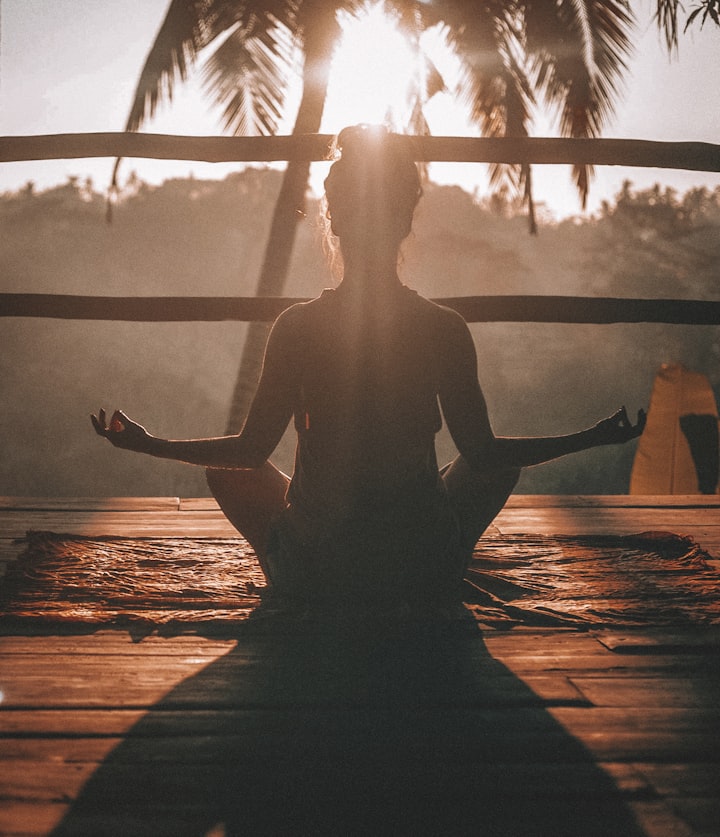A Guided Meditation for Relaxation and Clarity"
"Discovering Stillness and Tranquility Within Yourself"

There are many types of meditation, each with its own unique approach and purpose. Here are some of the most common types of meditation:
Mindfulness meditation
Mindfulness meditation is a type of meditation that involves paying attention to your thoughts, feelings, and physical sensations in a non-judgmental way, with the aim of developing greater awareness and understanding of your inner experiences. This practice is rooted in the Buddhist tradition, but has been adapted and popularized in the West as a secular form of mental training.
During mindfulness meditation, you sit in a comfortable position and focus your attention on your breath or another anchor, such as a sound or sensation. When your mind wanders, as it inevitably will, you simply notice this and gently bring your attention back to your anchor. The idea is to cultivate a non-judgmental, accepting attitude towards whatever arises in your mind, without getting caught up in thoughts, worries, or distractions.
Through regular practice, mindfulness meditation can help reduce stress and anxiety, increase resilience and emotional regulation, improve attention and focus, and enhance overall well-being. It has been shown to have numerous benefits for both mental and physical health, including reducing symptoms of depression, anxiety, and chronic pain.
There are many different approaches to mindfulness meditation, and it can be practiced in a variety of settings, from guided group sessions to individual practice at home. It's a simple yet powerful tool for cultivating greater awareness and presence in your daily life.
Transcendental meditation
Transcendental Meditation (TM) is a technique of meditation that involves the use of a specific mantra, which is a sound or phrase that is repeated silently to oneself during the practice. The technique was developed by Maharishi Mahesh Yogi in the 1950s and has since gained popularity worldwide.
In TM, the practitioner sits in a comfortable position with their eyes closed, and focuses on the repetition of the mantra. The mantra is chosen specifically for the individual practitioner based on their age and gender, and is meant to be a "mental vehicle" that helps to quiet the mind and promote relaxation.
The practice of TM is typically taught by a certified instructor, who provides individualized instruction and guidance. The technique is practiced for 20 minutes, twice a day, and is said to promote deep relaxation and a sense of inner calm.
TM has been the subject of numerous scientific studies, which have shown that it can help reduce stress and anxiety, lower blood pressure, and improve overall well-being. It has also been shown to have positive effects on brain function, with studies showing increased activity in the prefrontal cortex, which is associated with higher-level thinking and decision-making.
Yoga meditation
Yoga meditation is a type of meditation that is often practiced in conjunction with physical postures and breathing exercises, as part of the larger system of yoga. The practice of yoga meditation involves focusing the mind on a specific object, such as the breath, a mantra, or an image, in order to achieve a state of inner calm and concentration.
The physical postures of yoga, known as asanas, are designed to help prepare the body for meditation by releasing tension and increasing flexibility. The breathing exercises, or pranayama, are also an important aspect of yoga meditation, as they help to quiet the mind and bring greater awareness to the present moment.
In yoga meditation, the practitioner may use a specific technique or method, such as counting the breath or repeating a mantra, in order to focus their attention and quiet the mind. The goal is to achieve a state of deep relaxation and inner peace, while also developing greater self-awareness and insight.
Yoga meditation is often practiced in a group setting, such as a yoga class, but can also be done on an individual basis at home. There are many different styles of yoga, each with its own approach to meditation, so it's important to find a style that resonates with you and meets your individual needs.
Yoga meditation has been shown to have numerous health benefits, including reducing stress and anxiety, improving mood and well-being, and enhancing overall physical health and fitness. It's a powerful tool for cultivating greater awareness and presence in your daily life, and can help you connect more deeply with your body, mind, and spirit.
Vipassana meditation
Vipassana meditation is a traditional Buddhist practice that involves developing mindfulness and insight through the observation of one's thoughts, emotions, and bodily sensations. The word "vipassana" is derived from the Pali language and means "insight" or "clear seeing."
In Vipassana meditation, the practitioner sits in a comfortable position and focuses their attention on their breath or bodily sensations. The goal is to cultivate a non-judgmental awareness of one's experience, without getting caught up in thoughts, worries, or distractions.
As the practitioner continues to observe their experience, they may begin to notice patterns and habits in their thoughts and emotions, which can help to develop greater insight and understanding. Over time, the practice of Vipassana meditation can help to cultivate greater clarity, wisdom, and compassion.
Vipassana meditation is often practiced in intensive retreats, where practitioners engage in long periods of silent meditation and follow a strict schedule of activities, such as meditation, work, and study. However, it can also be practiced on an individual basis, and there are many resources available for learning and practicing Vipassana meditation at home.
Vipassana meditation has been shown to have numerous benefits for mental and physical health, including reducing stress and anxiety, improving mood and well-being, and enhancing overall cognitive function. It is a powerful tool for developing greater awareness and insight into one's experience, and can help to cultivate greater compassion and connection with others.
Zen meditation
Zen meditation, also known as Zazen, is a form of meditation that is central to the practice of Zen Buddhism. It is a seated meditation practice that involves sitting in a particular posture and focusing on the breath or a specific object of meditation, such as a mantra or koan
The goal of Zen meditation is to quiet the mind, gain insight into the nature of reality, and ultimately achieve enlightenment. It is believed that through regular practice, one can cultivate a state of mindfulness and awareness that extends beyond the meditation cushion and into everyday life.
The practice of Zen meditation involves sitting in a cross-legged position on a cushion or bench, with the back straight and the eyes slightly open or closed. The focus is on the breath, and the practitioner is encouraged to observe the thoughts and sensations that arise without judgment or attachment.
While Zen meditation can be challenging for beginners, it is a rewarding practice that can lead to greater self-awareness, inner peace, and spiritual growth. It is often taught in Zen centers or by experienced teachers, who can provide guidance and support to those new to the practice.
Chakra meditation
Chakra meditation is a type of meditation that focuses on the seven energy centers or chakras in the body. These chakras are believed to be located along the spinal column and are associated with different physical, emotional, and spiritual aspects of the self.
The goal of chakra meditation is to balance and activate the chakras, allowing energy to flow freely through the body and promoting physical, emotional, and spiritual well-being. Each chakra is associated with a different color, sound, and element, and focusing on these aspects during meditation can help to activate and balance the chakras.
During chakra meditation, practitioners may visualize each chakra and its corresponding color, chant a specific sound associated with the chakra, or use guided imagery to focus their attention on each chakra in turn. Some practitioners may also use crystals or essential oils associated with each chakra to enhance the meditation experience.
Chakra meditation can be a powerful tool for self-exploration and spiritual growth, but it is important to approach the practice with respect and caution. It is recommended to seek guidance from an experienced teacher or practitioner, especially if you are new to meditation or have specific health concerns.
These are just a few examples of the many types of meditation. It is important to find a type of meditation that works for you and to practice regularly to experience its benefits.





Comments
There are no comments for this story
Be the first to respond and start the conversation.